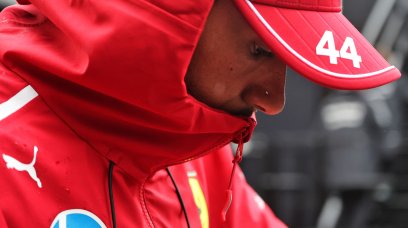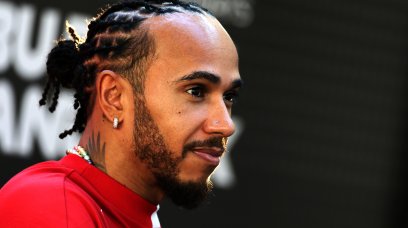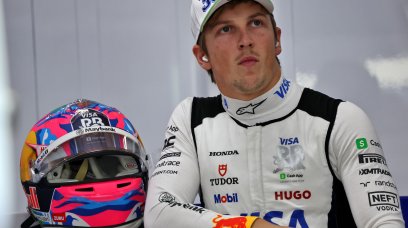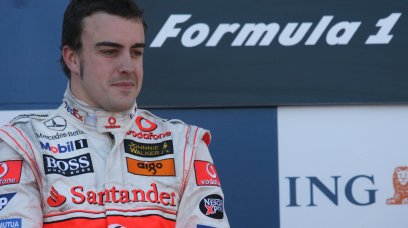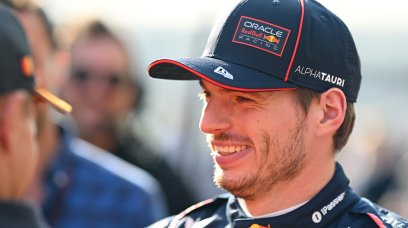Within any sporting arena, there will be individuals who are willing to bend, and flat out break the rules in order to gain a crucial advantage. This is even more apparent in the world of Formula 1, where the margins are so small, and the difference between victory or defeat can be mere milliseconds. Here are some of the most controversial scandals that have happened in F1's long and storied history. These were moments that stunned, angered, and perplex fans in almost equal measure.
1982 driver strike
We begin with the one and only time that drivers en masse flat out refused to race. In 1982, drivers had far less of a say on sporting matters than they do today. Team bosses and FISA, F1's governing body at the time, very much controlled matters from top to bottom, leading a strike on the eve of the first race of that season. Due to take place at South Africa's Kyalami track, drivers arrived at the circuit horrified by new Superlicence terms proposed by FISA moving forwards. In essence, the body wanted drivers to agree to sweeping new rules that would make criticising the sport's bosses illegal, while also giving teams the ability to swap drivers without their say-so. All drivers bar one agreed to strike, led by the two biggest opponents of the rule changes, Didier Peroni and Niki Lauda. Nobody took to the track for Thursday practice, before a temporary truce was put in place to assure the race did eventually go ahead one week later than planned. The strike was avoided, and in the aftermath, F1 drivers and the court of Arbitration for sport ensured they would not have to sign FISA's new terms. The incident proved to be a pivotal turning point for F1, as driver influence grew exponentially in the coming years and decades.
Prost v Senna
In 1988, Alain Prost and Ayrton Senna's first season together at McLaren, it was Senna who emerged victorious to win his very first title. By 1989 however, Senna was the hunter, needing to beat Prost on track at the final race in Suzuka to win his second championship. The Brazilian got off to a terrible start, going from 1st to third by the end of the opening lap. On fresh tyres, Senna soon caught up to the race leader, but their battle would end in disaster when Prost turned into Senna at the final chicane, damaging the latter's front wing. Prost's damage was terminal, but incredibly, Senna recovered to win the race - and therefore the championship. Shockingly, Ayrton was then disqualified for using an escape road to recover from the incident. A year later, the pair would once again meet at Suzuka for another iconic tussle. This time, it was Senna who held a slim championship lead, meaning that he would be victorious if Prost - who now drove for Ferrari - failed to finish. At the first corner, the McLaren driver went for a gap that simply wasn't there, taking both himself and Prost out of the race. Senna had exacted his revenge, even if he did insist that the crash wasn't intentional.
Jerez's 1997 title decider
It has gone down in infamy as one of the most dramatic title deciders we've ever seen in F1. In 1996, Ferrari's Michael Schumacher was going head to head against Williams driver Jacques Villeneuve for the driver's world championship. Heading into the final race of the season at Jerez, Schumacher held a one-point lead over Villeneuve, leading to what was essentially a final race shootout. They were inseparable during qualifying, with Schumacher, Villeneuve and the Canadian's teammate, Heinz-Harald Frentzen, all setting the same time down a thousandth of a second. In the race itself, Schumacher leaped frogged his rival into an early lead, but when Villeneuve caught up and attempted an overtake, disaster struck. Just as he had done to Damon Hill in 1994, Schumacher instinctively turned into Jacque's Williams, in what looked like an intentional move to try and nullify his rival. Unlike in 1994, the car he crashed into was able to continue the race, with Villeneuve nursing his car home to win his first and only drivers world title. By contrast, Schumacher was forced to retire in acrimonious circumstances, and the FIA would take a dim view of his actions The governing body opted to strip the German of his second-place finish in the 1997 championship standings.
2005 U.S Grand Prix
New fans of F1 will only know the sport as having one sole tyre supplier. Since 2010, the supplier in question has been Pirelli, but back in 2005, Formula 1 was in the midst of a tyre war - as two manufacturers went head to head. Ferrari, Jordan and Minardi all used Bridgestone rubber, while the rest of the field was supplied by Michelin. When Toyota's Ralf Schumacher smashed into Indianapolis' notorious concrete wall at high speed during Friday's practice session, the Michellin tyres were suddenly under scrutiny. Unable to assure the drivers and teams that their compounds were safe to race on, all of the Michelin runners would be forced to withdraw from the 2005 U.S Grand Prix Last-minute compromises, such as implementing a chicane before the pit straight, were all rejected due to economic and political pressure. It led to a comical spectacle, as well over half the field drove back into the pitlane after the formation lap, leaving just the six Bridgestone cars out on track. Michael Schumacher won his only race that season for Ferrari, while Thiago Montiero got on the podium for Jordan - only to be greeted by a chorus of boos and jeers emanating from a bewildered Indianapolis crowd.
Schumacher's Rascasse antics
Michael Schumacher is one of the greatest drivers F1 has ever seen, but as his second entry on this list shows, he also didn't shy away from doing whatever it took to win races and championships. After a miserable 2005 season, the German was firmly back in the title fight for 2006, up against the young challenger, Renault's Fernando Alonso. The Spaniard had triumphed the season prior, but with Ferrari back to their best in 2006, he wasn't expected to enjoy such an easy ride this time around. By the time of the Monaco Grand Prix, the pair were already the clear championship contenders - with both going all out for pole position around the streets of Monte-Carlo. However, after putting his Ferrari on provisional pole, Schumacher decided to exploit Monaco's narrow layout by the time of his final flying lap attempt. The German appeared to fake running wide at Rascasse - the penultimate corner - which in turn meant that neither he nor Fernando Alonso behind could improve their lap times. Schumacher qualified on pole by default, but under a grey cloud, as the move looked very suspicious. The race stewards thought so as well, and as such, demoted the seven-time world champion to the back of the grid. It was an ill-judged decision that possibly cost him that year's championship, which was ultimately won by Alonso.
Spygate
It was F1's very own James Bond plot. For the 2007 season, Ferrari's biggest rival for the constructor's championship was a rejuvenated McLaren, whose cars were being driven by reigning world champion Fernando Alonso, and a young rookie named Lewis Hamilton. With the racing between the two teams being so close throughout the season, both were looking for any small advantage they could find - and by the midway point, McLaren thought they had found one. Ferrari's chief mechanic, Nigel Stepney, disgruntled at not getting a promotion with the team, started to leak information and details about their 2007 car to McLaren. The spying was only uncovered when a Ferrari fan at a photocopying shop in Woking notified Maranello that a man, who turned out to be McLaren engineer Mike Coughlan, was copying what appeared to be confidential team documents. Both he and Stepney were soon outed, and McLaren were disqualified from the 2007 constructors championship - and being hit with a $100m fine for attempting to utilize the data that Stepney handed over.
Crashgate
Just when you thought F1 couldn't get any more dramatic or controversial, along came Crashgate. As its name suggests, it involved a driver, in this case, Renaults' Nelson Piquet Jr, who intentionally crashed into the barrier in order to bring out a safety car. At the 2008 Singapore Grand Prix, Renault's Fernando Alonso looked like the man to beat, despite being in a fairly uncompetitive car for most of the season. After pitting early, Renault chiefs Flavio Briatore and Pat Fry knew that a safety car would hand them a huge advantage for the rest of the race. They, therefore, decided to execute a plan that had been discussed before the Grand Prix, which involved Alonso's teammate, Piquet Jr, crashing into the wall on purpose. The safety car duly came out, and Alonso romped home to take his only win of the season. All the while, the story rumbled on behind the scenes at Renault. After being sacked by the team for a string of poor performances in 2009, Piquet went public, revealing the full extent of the incident and how he was told to crash at a certain time. Briatore was handed a life ban from F1, while Fry was banned for five years, in what was a truly shameless chapter that left a permanent stain on the sport.
'Fernando is faster than you'
At the 2010 German Grand Prix at Hockenheim, Fernando Alonso and Sebastian Vettel were busy fighting each other for the lead, when Alonso's teammate, Filipe Massa, swept past both of them to get out in front. After a half-attempt from Alonso to pass his teammate while lapping backmarkers, and some intense discussion on the Ferrari pit wall, Massa’s engineer Rob Smedley uttered those now-infamous five words: “Fernando is faster than you”. Massa let Alonso – by this point still an outside challenger for the championship – past coming out of the hairpin as Ferrari secured the one-two. As well as seeming like a thoroughly cruel decision against a driver who’d been through so much in the years prior, it was also controversial because team orders were, at this point, banned. Ferrari offered a token denial, despite the fact it was painfully obvious a team order, but the FIA were left in an awkward position – as they couldn’t really punish the Italian team. Instead, Ferrari was pinned on the grounds of “bringing the sport into disrepute” and were handed a $100,000 fine.
Most read
